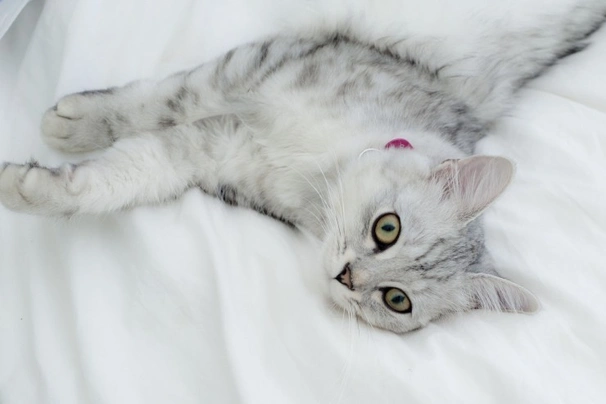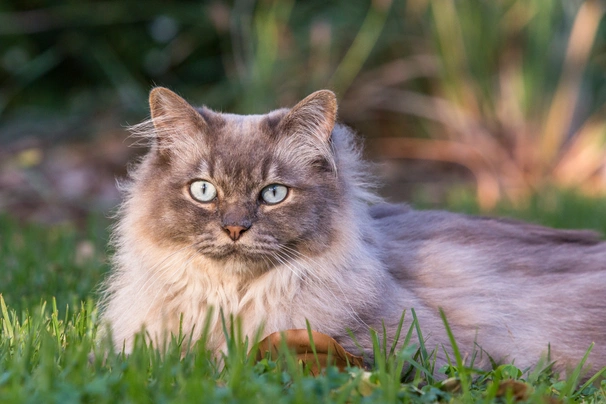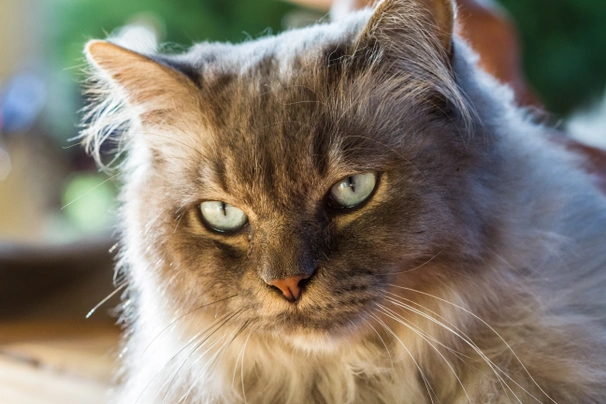Tiffanie
Introduction of the Tiffanie
The Tiffanie first appeared in the mid 1980s and is the only semi-longhaired variety in a group of breeds known by the Governing Council of the Cat Fancy (GCCF) as the Asian Group. This name is used for cats of Burmese shape and coat texture (but not Burmese coat colour pattern or length) which derive from Burmese crossed with other pedigree breeds and which also includes the Asian Self Asian Smoke Asian Tabby Bombay (a black Asian Self) and the Burmilla (a Burmese x Chinchilla cross). The Burmilla also referred to as an Asian Shaded originated in the UK in 1981 as the result of an 'accidental' mating between a Persian Chinchilla and a Burmese and although it is a breed in its own right it is also the founder breed of the Asian Group. The first Tiffanies were in effect semi-longhaired Burmillas with a shaded pattern although they are now bred in the full range of Asian colours and coat patterns. Interestingly the Asian Group were the first pedigree cat breeds in Britain to include good temperament as part of their Standard of Points. The Tiffanie is not to be confused with the very rare American Tiffany breed also known as a Chantilly which is a totally different variety altogether.
History of the Tiffanie
The Tiffanie emerged in the UK as a result of the breeding programme for Burmillas when it was discovered that when Burmillas carrying the longhaired gene (as a result of the Chinchilla background) were mated some of the offspring were semi-longhaired. At first the appearance of these kittens was not taken seriously and they were simply sold as pets as the Burmilla breeders were aiming to produce shorthaired silver shaded cats. However a group of breeders became very interested in this very pretty new variety and decided to breed them in their own right as a separate breed. Progress was slow in gaining recognition for the Tiffanie but eventually they achieved preliminary recognition under the GCCF in 1991 moving to full Championship status in 2003 although it is still very much a minority breed in terms of numbers bred. The Tiffanie will be found in the Foreign Shorthaired Section of a GCCF show despite the coat length as it is part of the Asian Group which otherwise is comprised of shorthaired cats. The parent Bermilla breed can be traced back to two cats owned by Baroness Miranda von Kirchberg in Britain when a male Chinchilla kitten named Jemari Sanquist (that she had bought as a pet for her husband) mated one of her Burmese female cats Bambino Lilac Fabergé totally unknown to her. The resulting kittens were born in 1981 all black shaded silver of good Burmese type and the breeder decided to develop this new breed giving it the name of Burmilla and it was first recognised by the GCCF in 1989.
Appearance of the Tiffanie
The Tiffanie is a medium-sized cat with the males reaching between 12-14 lbs and the females slightly less. They now appears in all the coat patterns of the Asian group of breeds - Smoke Tabby (Spotted Classic Mackerel or Ticked) and Self (a solid colour all over) as well as the original Shaded pattern deriving directly from the Burmilla. Although Tabby is a recognised pattern for the Asian Group (even though the pattern will be less distinct in the longer coat of the Tiffanie) it is not recognised in their Burmese cousins and neither does it appear in the Burmilla. The coat can be black blue chocolate lilac red cream caramel apricot cinnamon fawn black tortie (in all the basic colours) and silver (again in all the basic colours). Each colour is known as either 'Full Expression' or 'Burmese Colour Restriction' which means that the cat is either a Burmese colour or the unmodified Full Expression colour which is much darker with for example the Burmese brown becoming black. The coat itself is medium to long except over the shoulders where it may be shorter and is fine and silky in texture without a woolly undercoat. It should appear dense but lie flat along the spine with a glossy shine and it lengthens along the length of the body to form what look like frills along the lower edges of the body and the tail should be plume-like. The eyes are large and lustrous and set wide apart and can be any colour from yellow through to green.
Temperament of the Tiffanie
The Tiffanie has an enchanting temperament and although it displays some of the extrovert characteristics of the Burmese it is the quietest of the Asian cats with the more relaxed and laid back attributes of the Chinchilla. Like most breeds young Tiffanie kittens are very playful and mischievous but will develop into very intelligent and affectionate cats. They enjoy playing with a wide range of toys often retrieving things that are thrown for them and 'stealing' items that look fun to play with. They love attention and being part of active family life although it is advisable for the Tiffanie to have a feline companion for the times when their humans are out as they may otherwise feel rather lonely. They generally get on very well with other family pets and cope admirably with the sometimes over-enthusiastic handling by young children.
Intelligence / Trainability of the Tiffanie
The Tiffanie appears to be a long-lived variety with no health problems specific to the breed. In common with other cats they need annual vaccination boosters against the common feline ailments of flu and enteritis as well as against Feline Leukaemia if they go outdoors.
Children and other
The Tiffanie will eat most good quality proprietary brands of cat food but will also enjoy treats of cooked chicken ham and grated cheese. However cows' milk will probably give them a stomach upset and a bowl of water should always be available. The medium length coat doesn't tangle in the same way as its Chinchilla cousins nor does it take so long to groom but nevertheless it will need regular brushing and combing to keep it free of knots and to remove any dead hairs which could lead to furballs.


